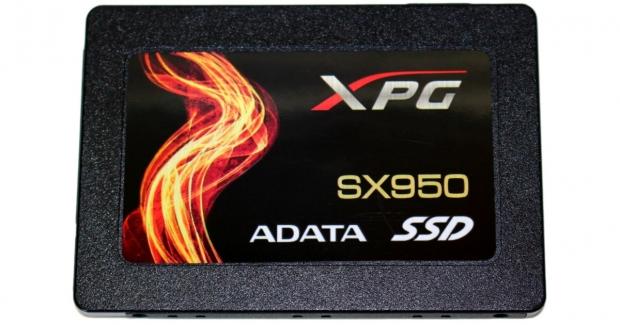
The Bottom Line
Introduction, Specifications, Pricing & Availability

It seems like we hardly get MLC-based SATA SSDs into the lab anymore. This is simply because MLC (2-bit) flash is approximately 33% more expensive per gigabyte than TLC (3-bit) flash, making MLC based SSDs a rare commodity these days. Price aside, 2-bit flash is typically superior to 3-bit flash for several reasons. The performance that 2-bit flash offers is better than 3-bit because it is faster to program 2-bits than it is 3-bits. Endurance is also better because 2-bit cells survive considerably more program/erase cycles than 3-bit cells. Power consumption is also less for MLC than it is TLC because it takes less power to program 2-bits than it does 3-bits.
The ADATA XPG SX950 we are going to review today sports an MLC 3D flash array. ADATA isn't going after the low-end market with their XPG SX950 Series, they have other drives for that. The XPG SX950 is targeted at the gaming crowd where premium components are in high demand and cost is secondary to quality. The XPG SX950 employs a 32-layer Micron 3D MLC flash array. Micron 256Gbit 2-bit 3D flash is built on proven floating gate architecture and manufacturing process. Floating gate technology gives Micron 3D flash the industry's highest areal density available today and CMOS under array keeps the footprint compact.
The ADATA XPG SX950 Gaming SSD pairs a 2-bit Micron 3D flash array with one of our favorite SATA controllers – Silicon Motion's 4-channel SM2258. The SM2258 is a favorite over for a couple of reasons. First, the SM2258 delivers exceptional moderate workload performance. Secondly, the SM2258 is one of the few controllers that offers advanced LDPC (Low-Density Parity Check) bit error correction. LDPC is special because it can greatly increase the endurance of a flash array. In addition to LDPC ECC, the XPG SX950 features RAID engine technology which strengthens data protection and integrity. Additionally, ADATA's XPG SX950 has intelligent SLC caching baked right in to further enhance burst performance. Pairing the LDPC enabled SM2258 controller with a 2-bit flash array gives the 480GB XPG SX850 a class-leading TBW of 400TB, as well as an almost unheard of 6-year warranty.
Let's take a quick look at the XPG SX950 480GB factory specifications and then dive into our benchmarks.
Factory Specifications

ADATA XPG SX950 480GB SATA III SSD:
- Sequential Read: up to 560 MB/s
- Sequential Write: up to 530 MB/s
- Max 4K Random Read Speed: up to 90,000 IOPS
- Max 4K Random Write Speed: up to 90,000 IOPS
- Endurance: 400TB
- MTBF: 2 Million Hours
- Warranty: 6-Year Limited Warranty
- Active Power Consumption: 0.82W Typical
- Slumber Power Consumption: 0.41W
- ECC
- SMART
- TRIM
- Garbage Collection
- Software: SSD Toolbox, Acronis True Image HD Migration Software
Current Pricing: $249.99
The ADATA XPG SX950 pairs Silicon Motion's SM2258 controller with Micron 256Gbit 32-layer 3D MLC (Multi-Level-Cell) flash in BGA flash packages. BGA packaged flash is the good stuff, it is capable of higher bus speeds than TSOP packaged flash. Table caching is handled by a single Nanya DDR3 DRAM cache package with a capacity of 1MB to 1GB DRAM to NAND ratio.
Drive Details
ADATA XPG SX950 480GB SATA III SSD
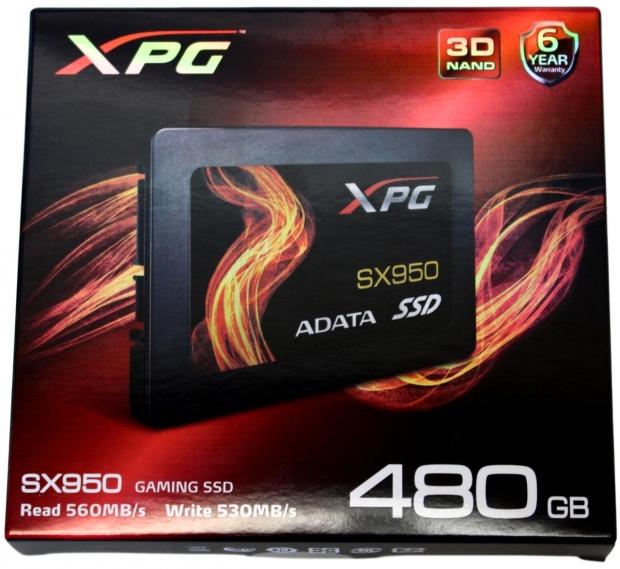
The red and black themed packaging advertises the XPG SX950 as a gaming SSD. The drive's 3D NAND, 6-year warranty, sequential read/write speeds and capacity are advertised on this side of the packaging.
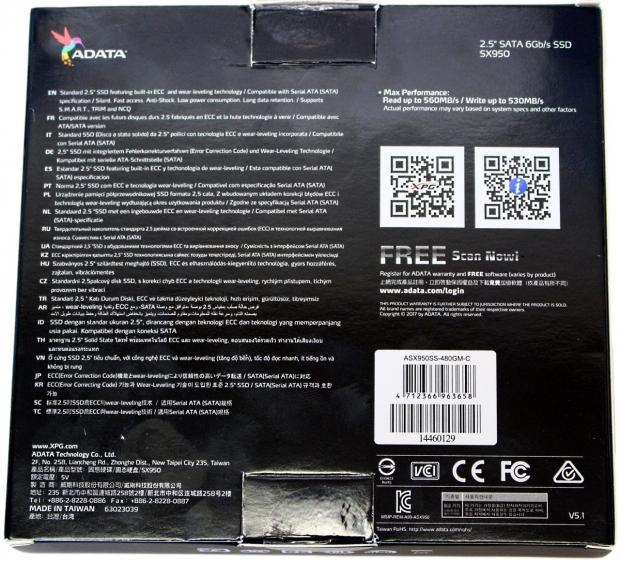
The rear of the packaging lists the drive's form-factor and included software available for download.
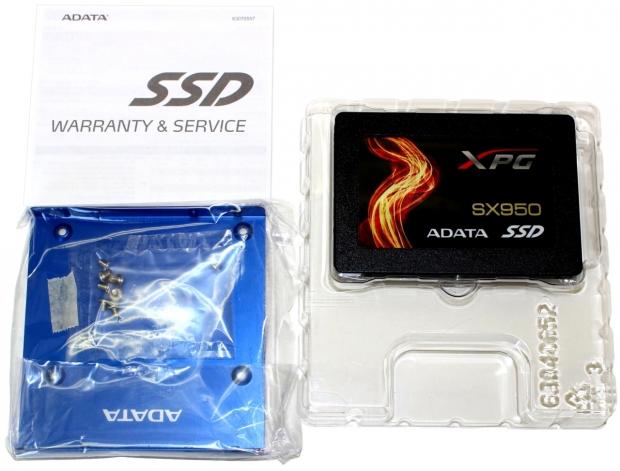
When you buy an XPG SX950, you also get a 3.5" to 2.5" adapter.
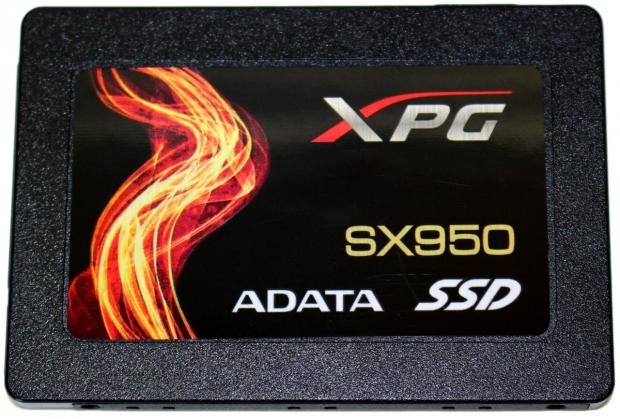
The top of the drive's enclosure is made of plastic. There is an attractive label at the center.

The bottom and sides of the enclosure are formed from metal. There is a manufacturer's label listing the particulars of the drive.

Popping the enclosure open reveals the back side of a half-length PCB.
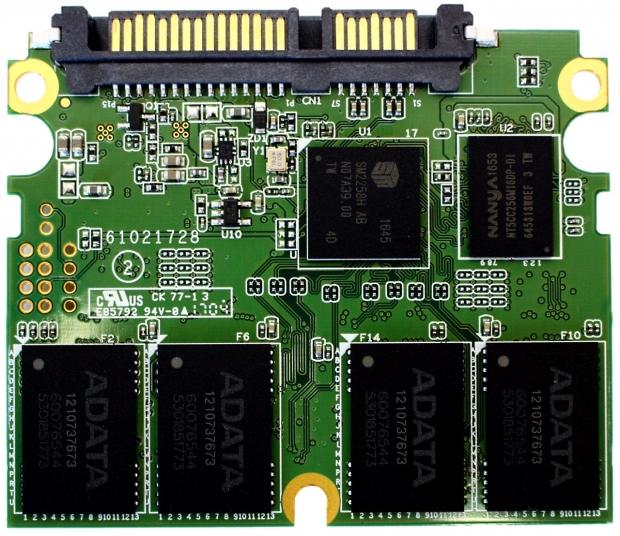
This side of the PCB houses four of the drive's eight 64GB, 32-layer 3D MLC flash packages, the drive's Silicon Motion SM2258 4-channel controller and a Nanya 512MB DDR3 DRAM package.
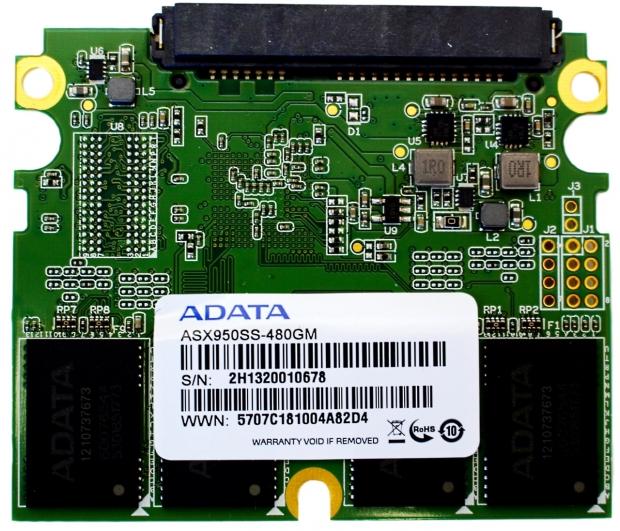
This side of the PCB houses four of the drive's eight 64GB, 32-layer 3D MLC flash packages. There is also an empty landing pad for an additional DRAM cache package for larger capacity models.
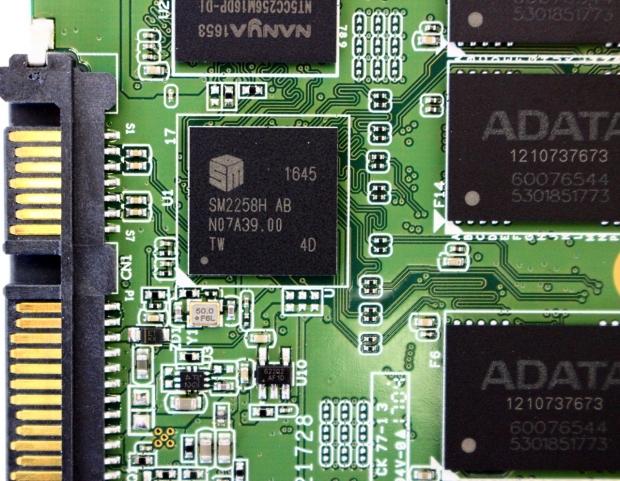
A close-in view of the drive's SM2258 4-channel controller.
Test System Setup and Properties
Jon's Consumer SSD Review Test System Specifications
- Motherboard: ASRock Extreme9 Z97 - Buy from Amazon
- CPU: Intel Core i7 4790K @ 4.8GHz - Buy from Amazon / Read our review
- Cooler: Swiftech H2O-320 Edge - Buy from Amazon / Read our review
- Memory: Corsair Dominator DDR3 32GB 2400MHz - Buy from Amazon
- Video Card: Onboard Video
- Case: IN WIN X-Frame - Buy from Amazon / Read our review
- Power Supply: Seasonic Platinum 1000 Watt Modular - Buy from Amazon / Read our review
- OS: Microsoft Windows 10 Professional 64-bit - Buy from Amazon
- Drivers: Intel RAID option ROM version 13.0.0.2075 and Intel RST driver version 14.8.0.1042
We would like to thank ASRock, Crucial, Intel, Corsair, RamCity, IN WIN, and Seasonic for making our test system possible.
Drive Properties
ADATA XPG SX950 480GB SATA III SSD OS Disk 75% Full
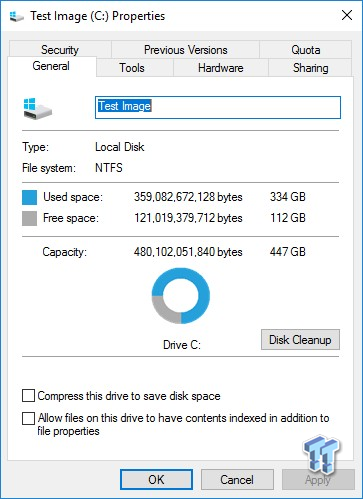
The majority of our testing is performed with our test drive as our boot volume. Our boot volume is 75% full for all OS Disk "C" drive testing to replicate a typical consumer OS volume implementation. We feel that most of you will be utilizing your SSDs for your boot volume and that presenting you with results from an OS volume is more relevant than presenting you with empty secondary volume results.
System settings: Cstates and Speed stepping are both disabled in our systems BIOS. Windows High-Performance power plan is enabled. Windows write caching is enabled, and Windows buffer flushing is disabled. We are utilizing Windows 10 Pro 64-bit OS for all of our testing except for our MOP (Maxed-Out Performance) benchmarks where we switch to Windows Server 2008 R2 64-bit. Empty Windows 10 benchmark screenshots will also be shown on our MOP page.
Synthetic Benchmarks – ATTO & Anvil's
ATTO
Version and / or Patch Used: 2.47
ATTO is a timeless benchmark used to provide manufacturers with data used for marketing storage products. With ATTO, we are looking at maximum sequential performance with compressible data as well as the performance curve.
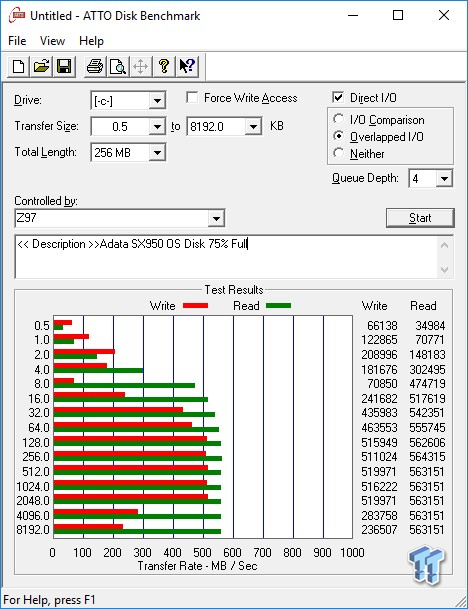
Compressible sequential read/write transfers max out at 564/519 MB/s. Keep in mind this is our OS volume, and it is filled to 75% of its total capacity.
Sequential Write
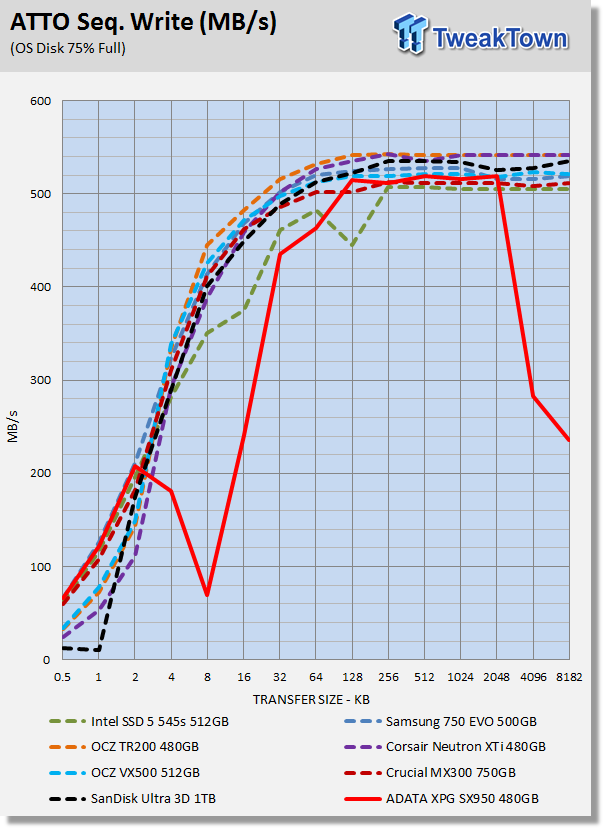
Sequential write performance is a bit choppy. This is likely due to the test being run right after filling the drive. We are fairly certain performance would smooth out if we gave the drive some additional idle time.
Sequential Read
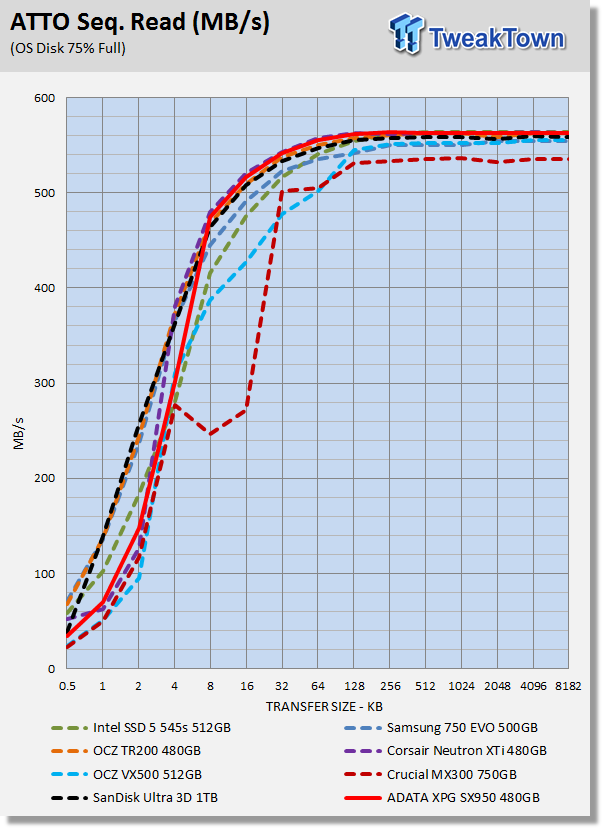
We are looking for a nice smooth performance curve, good small-file performance and high sequential performance on the top end. The XPG SX950 gives us two of the three we are looking for. We would like to see better small-file performance.
Anvil Storage Utilities
Version and / or Patch Used: 1.1.0
Anvil's Storage Utilities is a storage benchmark designed to measure the storage performance of SSDs. The Standard Storage Benchmark performs a series of tests; you can run a full test or just the read or write test, or you can run a single test, i.e., 4k QD16. With Anvil's, we are focused on the total score.
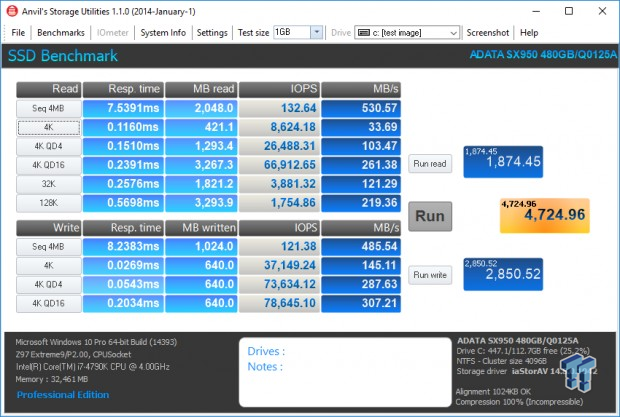
Scoring
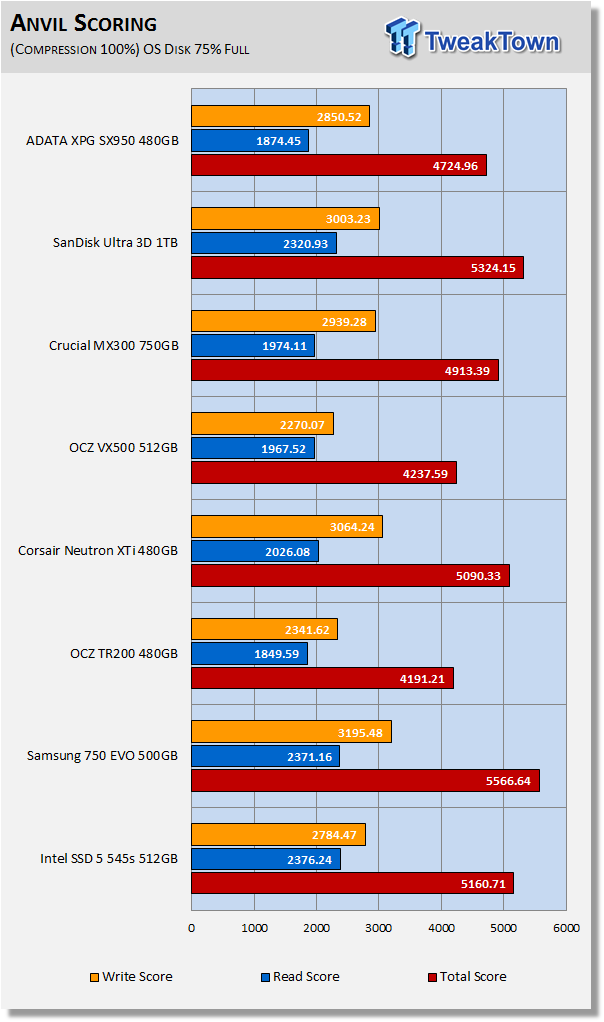
Anvil's scoring typically provides us with a good indication of a drive's overall synthetic performance. Here again, we would like to see a bit higher score, but we still consider a score of 4,700 to be decent.
(Anvil) Read IOPS through Queue Depth Scale
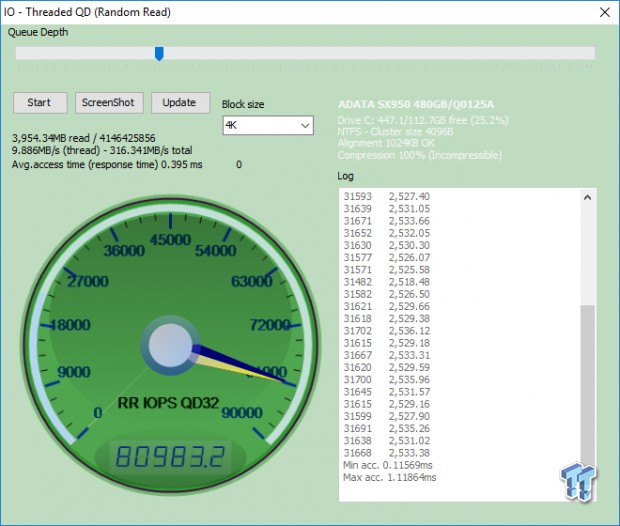
With the drive filled to 75% of its total capacity, we fall short of the 90K random IOPS listed on the factory spec. sheet.
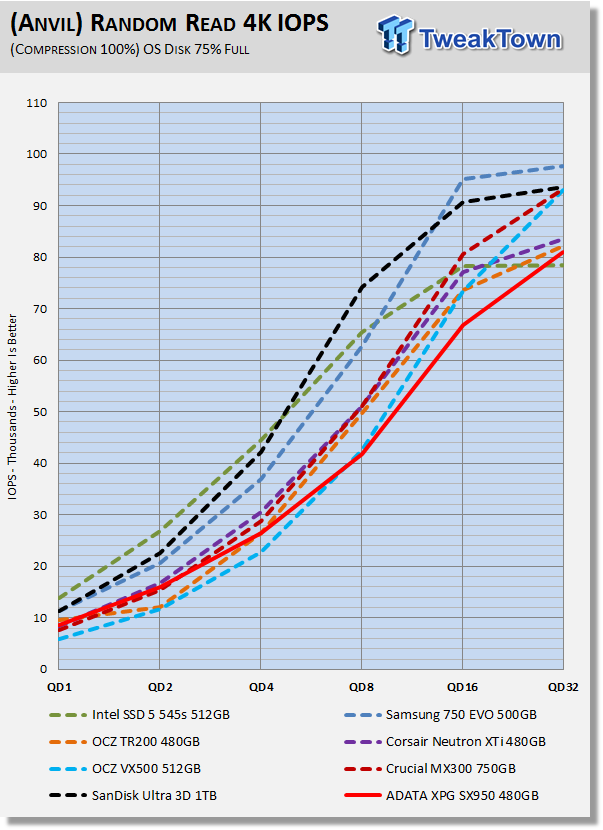
The XPG SX950 delivers respectable performance at QD1-QD2, but higher queue depths falls behind the rest of the drives in our test pool.
(Anvil) Write IOPS through Queue Scale
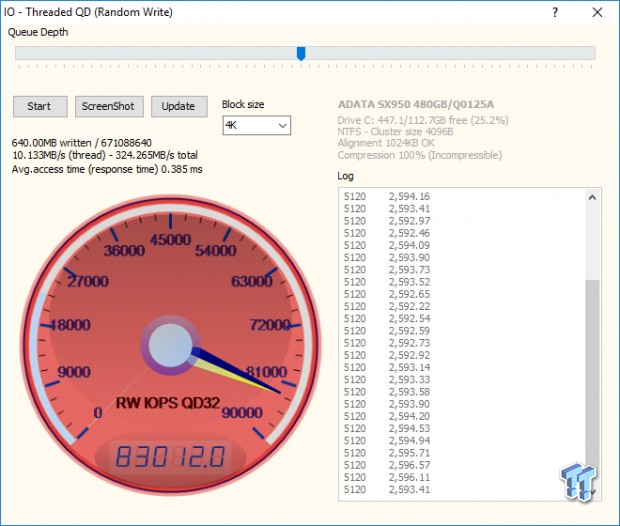
With the drive filled to 75% of its total capacity, we fall short of the 90K random IOPS listed on the factory spec. sheet.
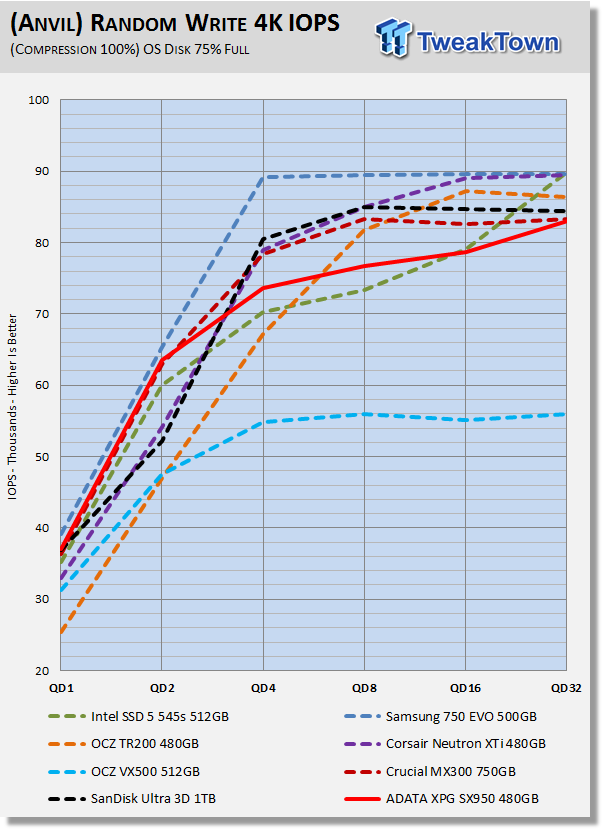
The XPG SX950 delivers fantastic low queue depth random write performance. It falls off the pace at higher queue depths, but that is fine because most transactions occur at QD1-QD2.
Synthetic Benchmarks – CDM & AS SSD
CrystalDiskMark
Version and / or Patch Used: 3.0 Technical Preview
CrystalDiskMark is disk benchmark software that allows us to benchmark 4k and 4k queue depths with accuracy. Note: Crystal Disk Mark 3.0 Technical Preview was used for these tests since it offers the ability to measure native command queuing at QD4. With this version of CDM, we are focused on 4K random performance at QD1 and QD4.
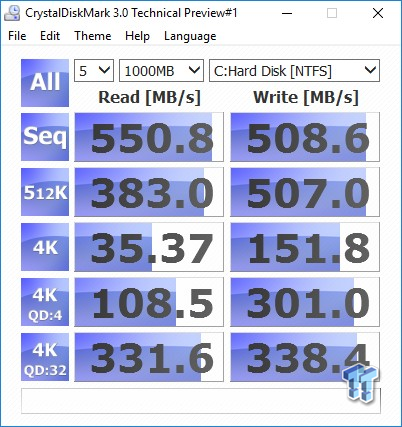
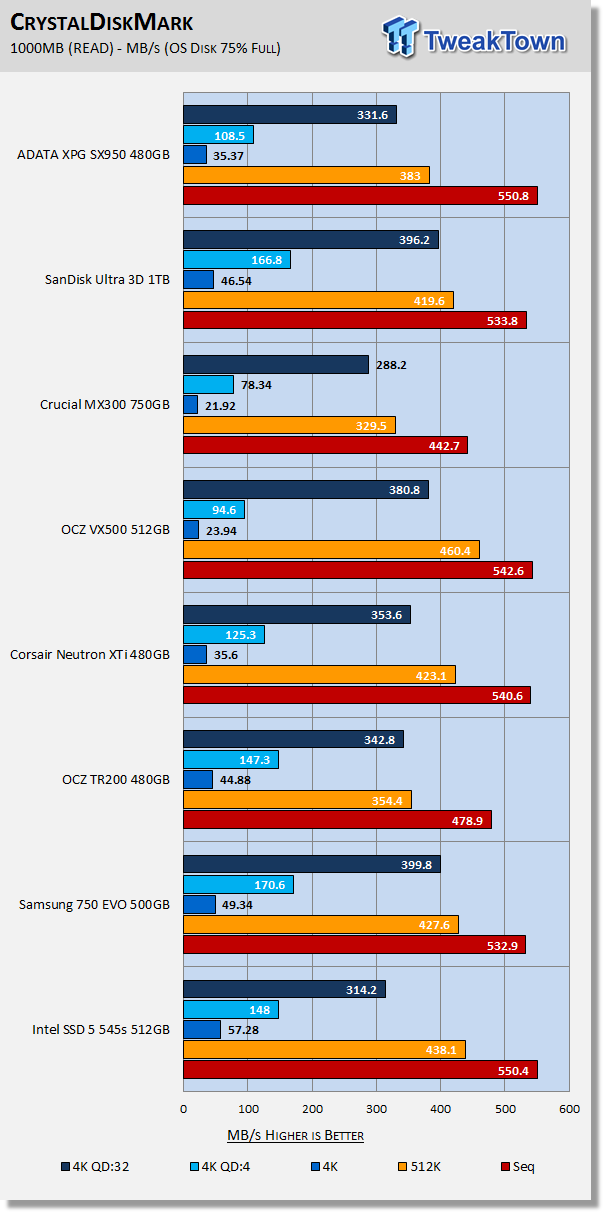
Like we saw from our Anvil testing, the XPG SX950 is more of a write centric SSD and only delivers average random read performance. However, when we look at sequential read, we find the XPG SX950 is the top performer.
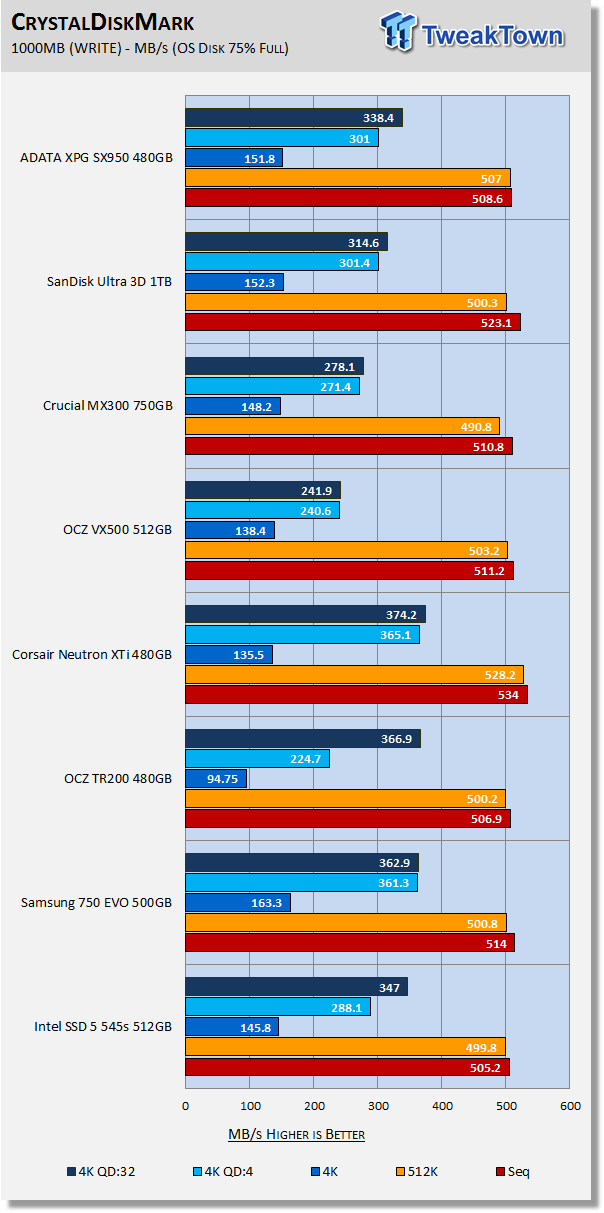
The XPG SX950 delivers the goods where it matters most – QD1. Again, the write centric nature of the XPG SX950 is on display.
AS SSD
Version and / or Patch Used: 1.8.5611.39791
AS SSD determines the performance of SSDs. The tool contains four synthetic as well as three practice tests. The synthetic tests are to determine the sequential and random read and write performance of the SSD. We focus on total score when evaluating AS SSD.
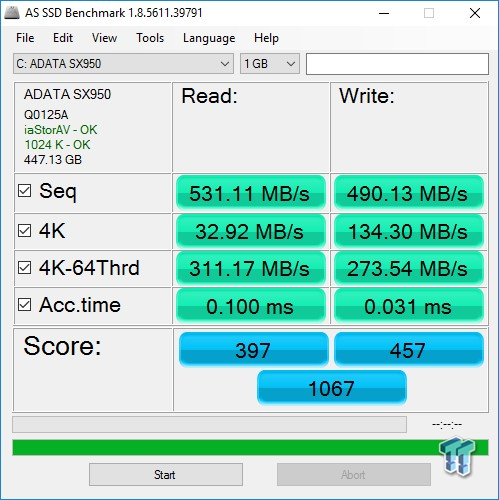
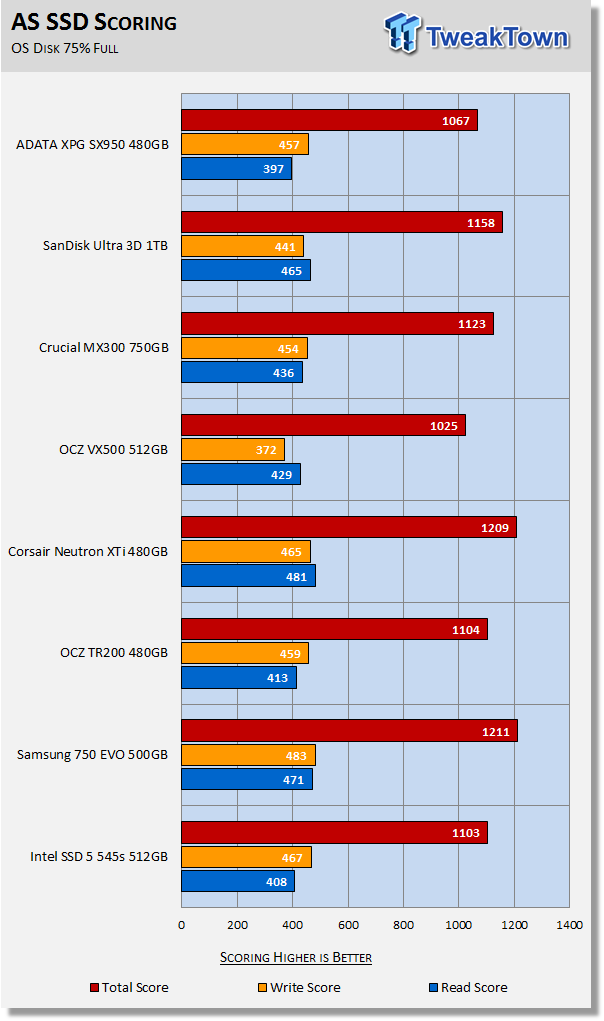
AS SSD is a demanding test. With AS SSD we are looking for a minimum score of 1000. The SX950 meets our minimum but certainly doesn't dazzle us with this performance.
Benchmarks (OS) - Vantage, PCMark 7, PCMark 8 & SYSmark 2014 SE
Consumer Workloads
We categorize these tests as indicative of a moderate workload environment.
PCMark Vantage - Hard Disk Tests
Version and / or Patch Used: 1.2.0.0
The reason we like PCMark Vantage is because the recorded traces are played back without system stops. What we see is the raw performance of the drive. This allows us to see a marked difference between scoring that other trace-based benchmarks do not exhibit. An example of a marked difference in scoring on the same drive would be empty vs. filled vs. steady state.
We run Vantage three ways. The first run is with the OS drive 75% full to simulate a lightly used OS volume filled with data to an amount we feel is common for most users. The second run is with the OS volume written into a "Steady State" utilizing SNIA's guidelines. Steady-state testing simulates a drive's performance similar to that of a drive that been subjected to consumer workloads for extensive amounts of time. The third run is a Vantage HDD test with the test drive attached as an empty, lightly used secondary device.
OS Volume 75% Full - Lightly Used
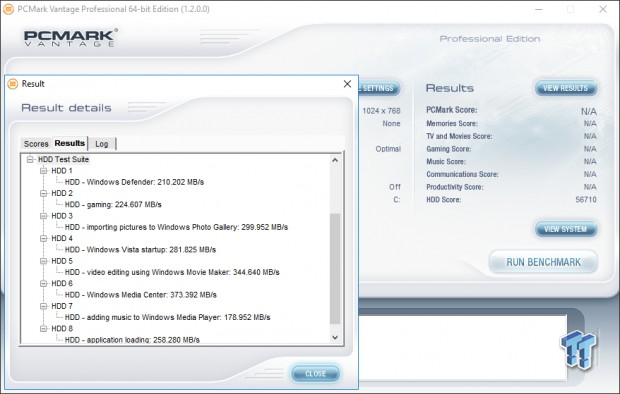
OS Volume 75% Full - Steady State
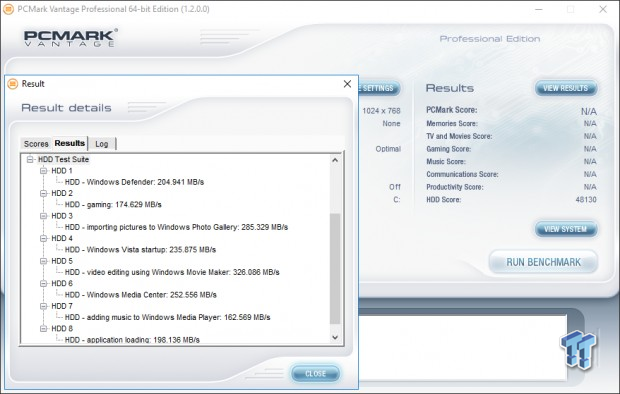
Secondary Volume Empty - FOB
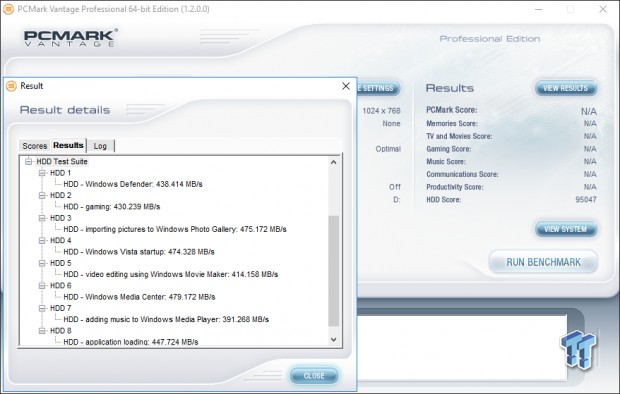
There's a big difference between an empty drive, one that's 75% full/used, and one that's in a steady state.
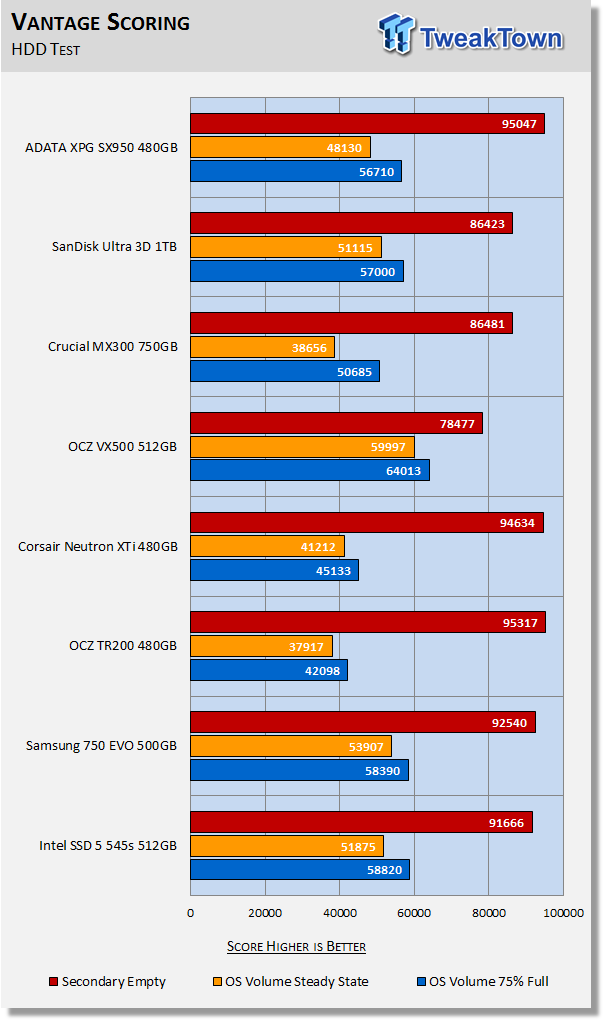
The important scores to pay attention to are "OS Volume Steady State" and "OS Volume 75% full." These two categories are most important because they are indicative of typical consumer user states. When a drive is in a steady state, it means garbage collection is running at the same time it's reading/writing. This is exactly why we focus on steady-state performance.
At 75% full, the XPG SX950 delivers Tier-1 performance. However, it does take a bit of a beating when in a steady state. The Crucial MX300 uses 3-bit Micron 32-layer 3D flash, and we can clearly see that in a steady state, the 2-bit equivalent used on the SX950 delivers much better performance.
PCMark 7 - System Storage
Version and / or Patch Used: 1.4.0
We will look to Raw System Storage scoring for evaluation because it's done without system stops and, therefore, allows us to see significant scoring differences between drives.
OS Volume 75% Full - Lightly Used
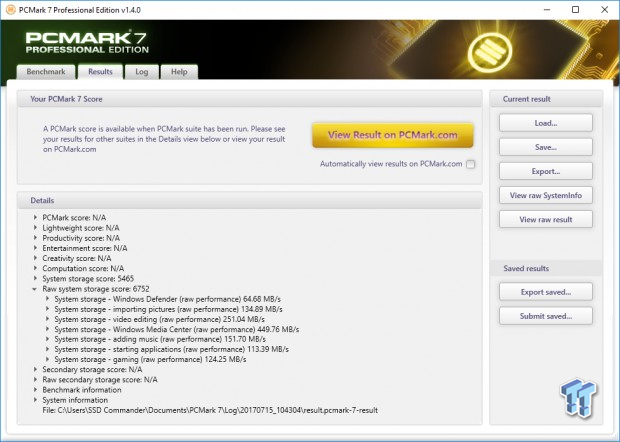
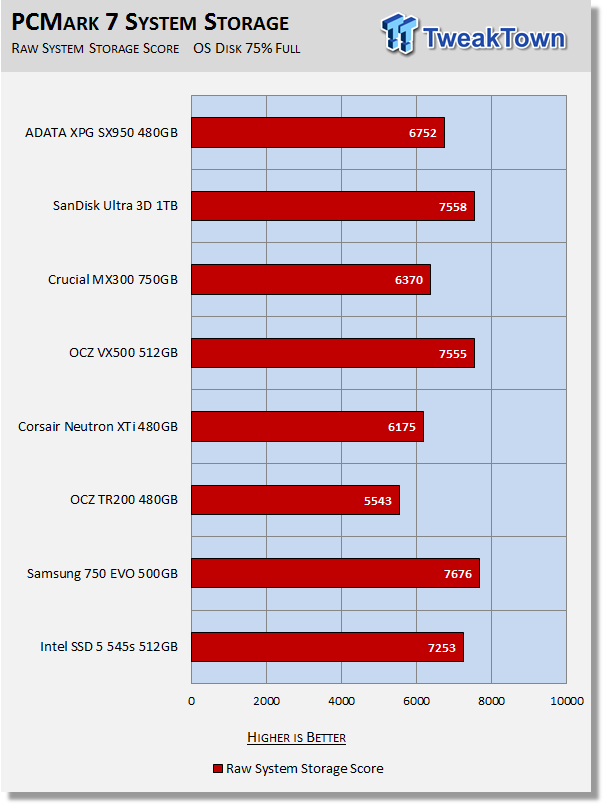
The XPG SX850 turns in a middle of the road performance with PCMark 7's dataset. It is significantly better than the Micron 3D TLC powered MX300, but compared to the better drives in our test pool it comes up a bit short.
PCMark 8 - Storage Bandwidth
Version and / or Patch Used: 2.4.304
We use PCMark 8 Storage benchmark to test the performance of SSDs, HDDs, and hybrid drives with traces recorded from Adobe Creative Suite, Microsoft Office, and a selection of popular games. You can test the system drive or any other recognized storage device, including local external drives. Unlike synthetic storage tests, the PCMark 8 Storage benchmark highlights real-world performance differences between storage devices. We focus on the total storage bandwidth when evaluating PCMark 8 results.
OS Volume 75% Full - Lightly Used
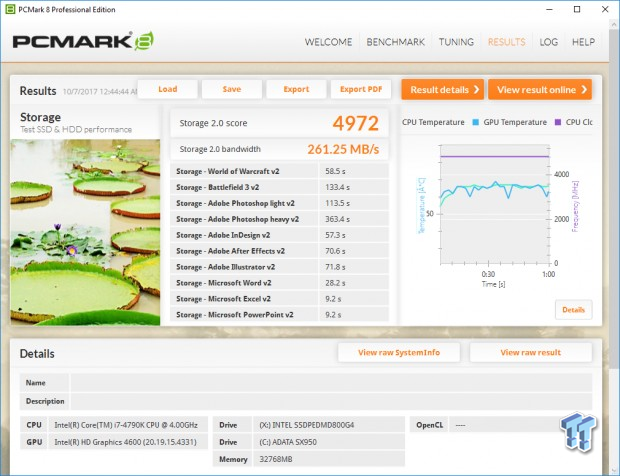
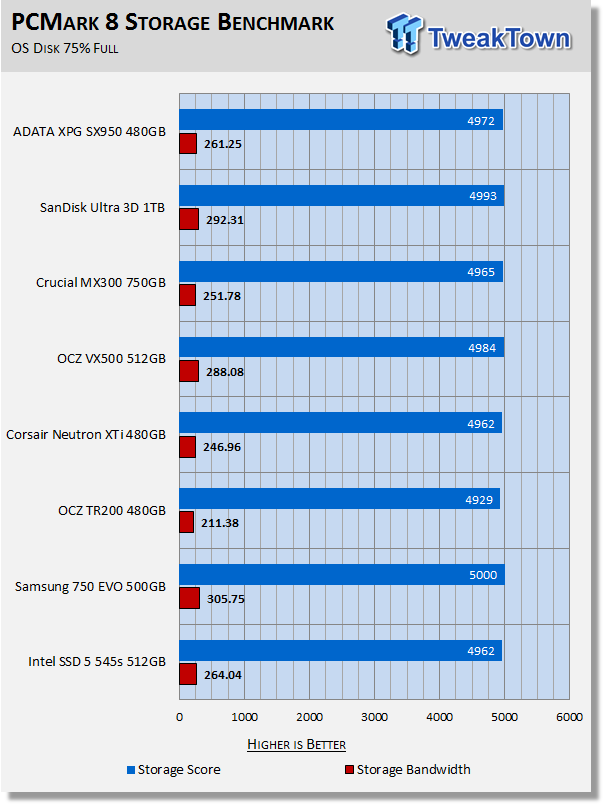
PCMark 8 is the most intensive moderate workload simulation we run. With respect to moderate workloads, this test is what we consider the best indicator of a drive's overall performance. The SX950 delivers a better than most total score. It is better than Intel's 3D TLC powered 545s - a drive that we are very fond of. The 545s has a bit more bandwidth, but the SX950 has better overall latency which is why it scores higher.
BAPCo SYSmark 2014 SE System Performance
Version and / or Patch Used: 2.0.0.70
SYSmark 2014 SE is considered the gold standard for testing system performance because it is an application based benchmark. This test gives us the ultimate in real-world results because it utilizes actual applications running on the system, instead of playing back recorded traces. If you want to know what kind of impact a particular SSD will have on your system's overall performance; this test will show you.
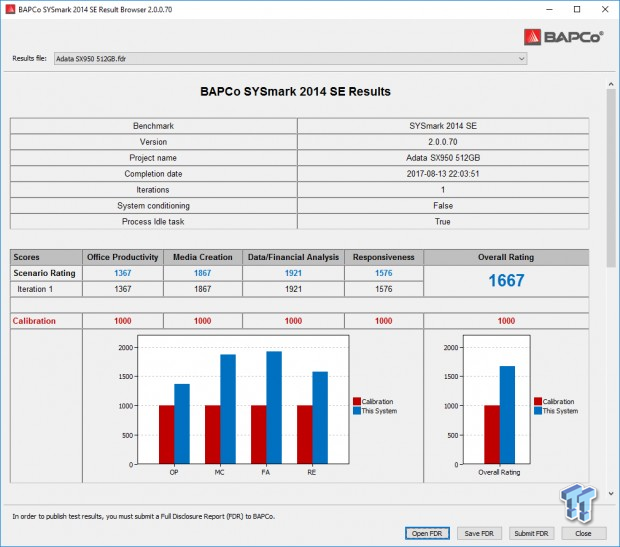
Disk performance has the greatest impact on the Responsiveness Score, so that is what we will focus on.
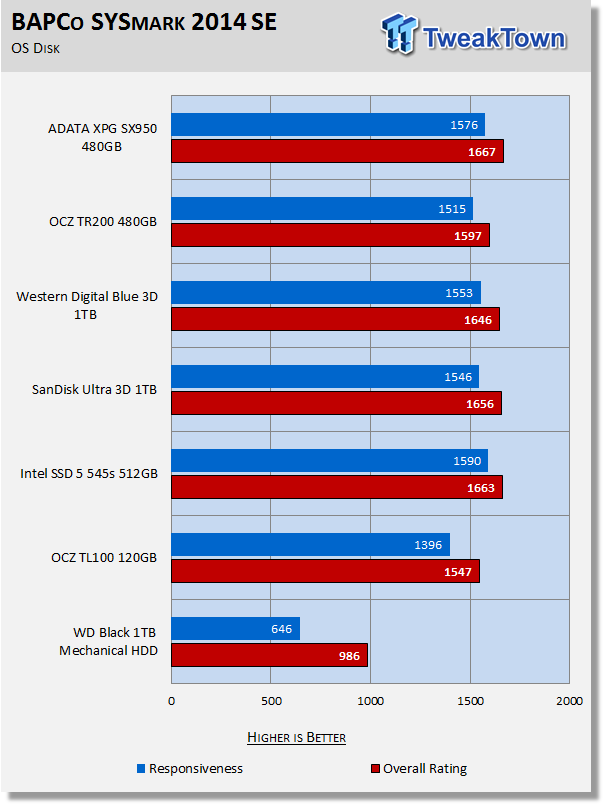
Our systems are much more powerful than the calibration system (1000-point baseline) used by BAPCo, so we ran an OCZ TL100 120GB SATA III SSD to establish a comparison point relative to our test systems. We will be running this test going forward, and we will add drives to our chart as we test them.
This test provides the kind of typical user workloads that really allow the ADATA XPG SX950 to show what it is made of. The XPG SX950 delivers the best score of any SATA SSD that we've run against this test to date. This is very impressive and certainly raises our opinion of the XPG SX950 greatly.
Note: we are replacing our PCMark 8 Extended testing with SYSmark because we believe SYSmark is much more relevant for consumer SSD testing.
Benchmarks (Secondary) – IOPS, Response & Transfers
Iometer – Maximum IOPS
Version and / or Patch Used: Iometer 2014
We use Iometer to measure high queue depth performance. (No Partition)
Max IOPS Read
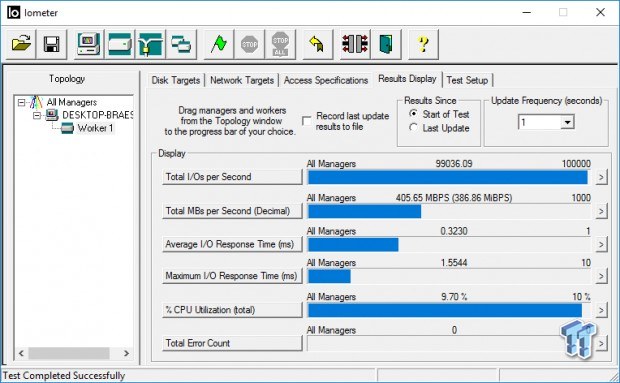
Max IOPS Write
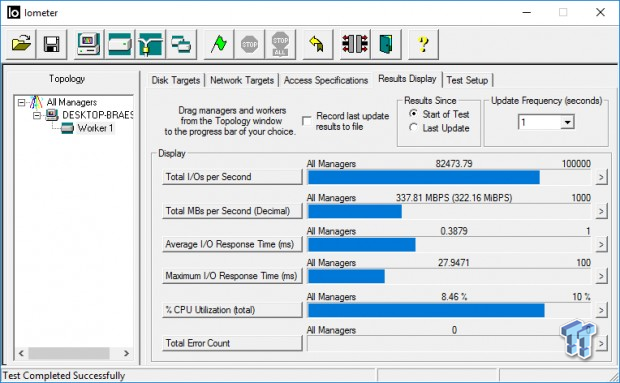
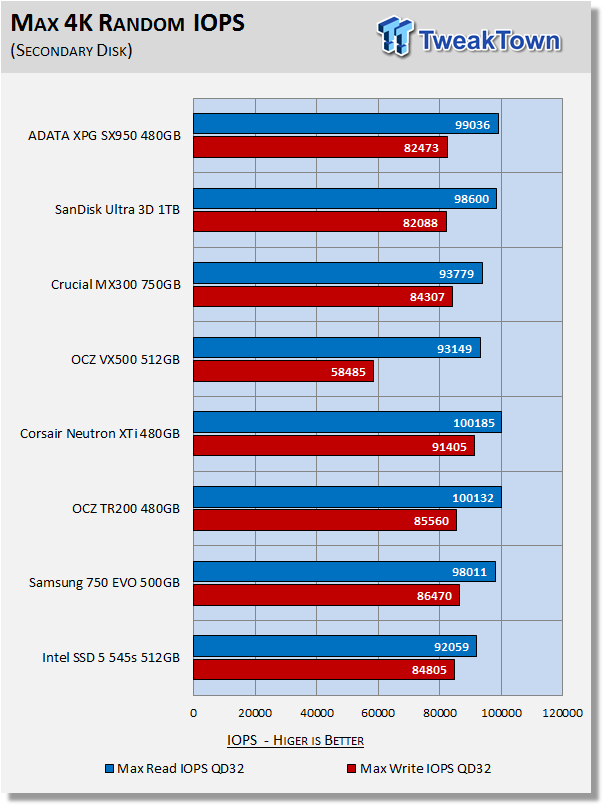
We are getting 9K more random read IOPS than the factory spec of 90K IOPS at QD32. However, we are 7K short of the 90K random write factory spec. We really have to wonder, where did this spec come from?
Iometer – Disk Response
Version and / or Patch Used: Iometer 2014
We use Iometer to measure disk response times. Disk response times are measured at an industry accepted standard of 4K QD1 for both write and read. Each test runs twice for 30 seconds consecutively, with a 5-second ramp-up before each test. We partition the drive/array as a secondary device for this testing.
Avg. Write Response
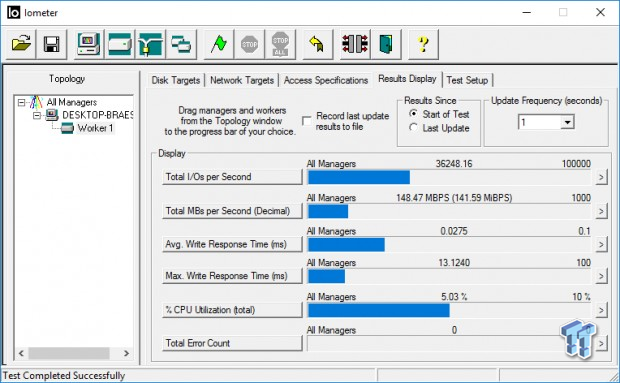
Avg. Read Response
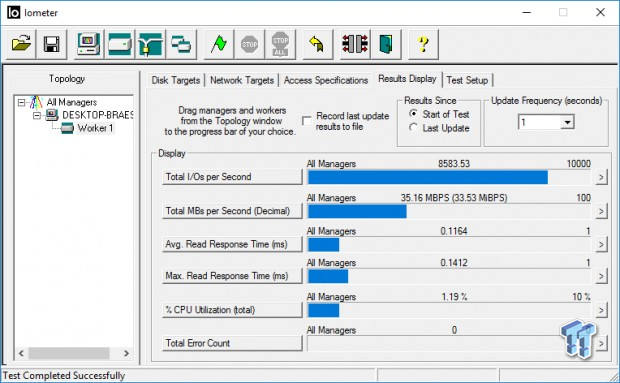
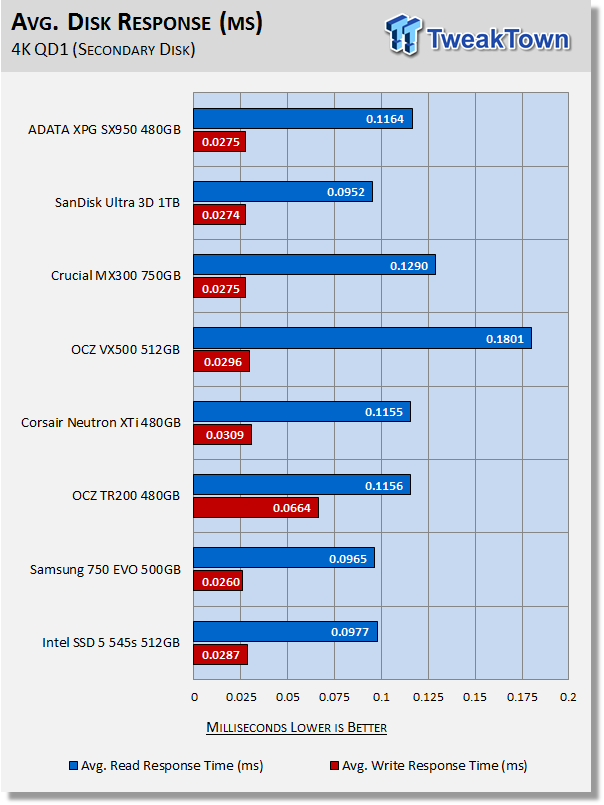
Only two drives in our test pool deliver better write response that the XPG SX950. The reverse is true of read response. Only two drives in our test pool deliver worse read response than the XPG SX950.
DiskBench - Directory Copy
Version and / or Patch Used: 2.6.2.0
We use DiskBench to time a 28.6GB block (9,882 files in 1,247 folders) composed primarily of incompressible sequential and random data as it's transferred from our DC P3700 PCIe NVME SSD to our test drive. We then read from a 6GB zip file that's part of our 28.6GB data block to determine the test drive's read transfer rate. Our system is restarted prior to the read test to clear any cached data, ensuring an accurate test result.
Write Transfer Rate
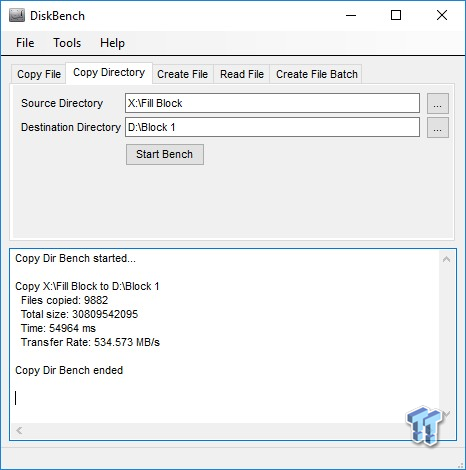
Read Transfer Rate
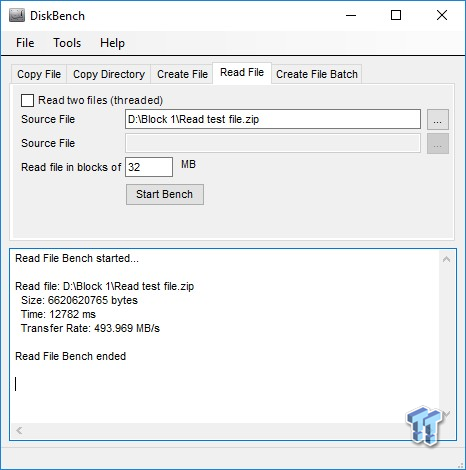
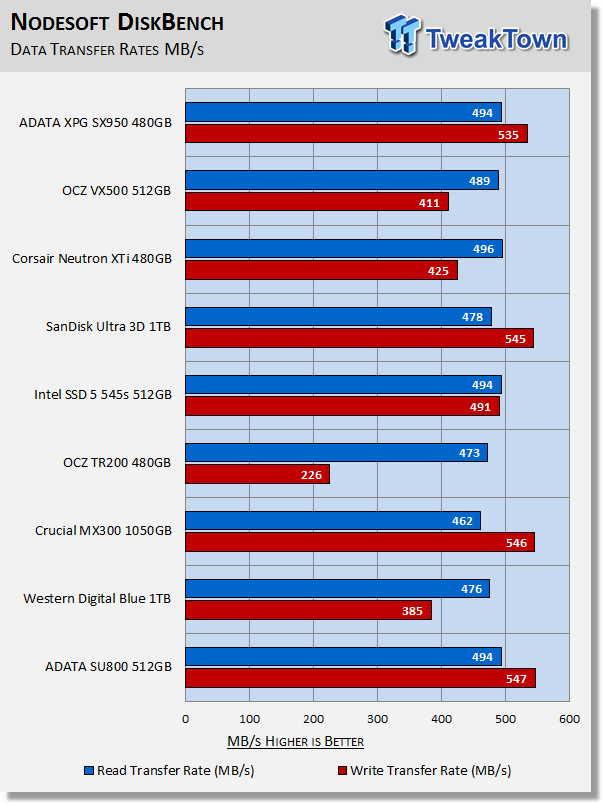
When testing write transfer rates, we have a rule of thumb. If any SSD cannot achieve 200MB/s with our write transfer test, that SSD will not receive a TweakTown recommendation. There are many TLC SSDs that do not pass our minimum, but we didn't include those on our chart. Additionally, we recently updated to Windows 10 Anniversary Edition and with that update, sustained write performance greatly increased. This means our previous transfer tests cannot be compared with those run on the newer version on Windows 10. This is the reason we only have a few drives on our chart.
Interestingly enough, read transfers are the second best of the drives in our test pool. Write transfers are also excellent – well over 500MB/s.
Benchmarks – 70/30 Mixed Workload & Sustained Sequential Write
70/30 Mixed Workload Test (Sledgehammer)
Version and / or Patch Used: Iometer 2014
Heavy Workload Model
This test hammers a drive so hard we've dubbed it "Sledgehammer." Our 70/30 Mixed Workload test is designed to simulate a heavy-duty enthusiast/workstation steady-state environment. We feel that a mix of 70% read/30% write, full random 4K transfers best represents this type of user environment. Our test allows us to see the drive enter into and reach a steady state as the test progresses.
Phase one of the test preconditions the drive for 1 hour with 128K sequential writes at QD32. Phase two of the test runs a 70% read/30% write at QD32, full random 4K transfer workload on the drive for 1 hour. We log and chart (phase two) IOPS data at 5-second intervals for 1 hour (720 data points). 60 data points = 5 minutes.
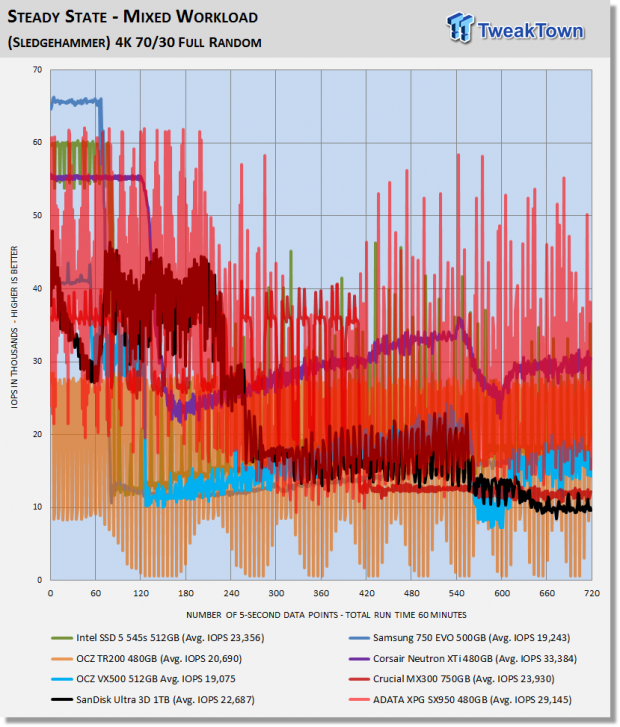
What we like about this test is that it reflects reality. Everything lines up, as it should. Consumer drives don't outperform Enterprise-Class SSDs that were designed for enterprise workloads. Consumer drives based on old technology are not outperforming modern Performance-Class SSDs, etc.
OP and capacity have a lot to do with the results of this test. This is actually very impressive. At an average of 29K IOPS, the XPG SX950 is second only to the Neutron XTi. This result tells us that the XPG SX950 can handle the heaviest of workloads with relative ease. This performance is as good as we see from many NVMe SSDs.
Sustained Sequential Write
Version and / or Patch Used: Iometer 2014
Heavy Workload Model
We write to the drive for 1 hour with 128K sequential writes at QD32. We log and chart megabytes per second data at 5-second intervals for 1 hour (720 data points). 60 data points = 5 minutes.
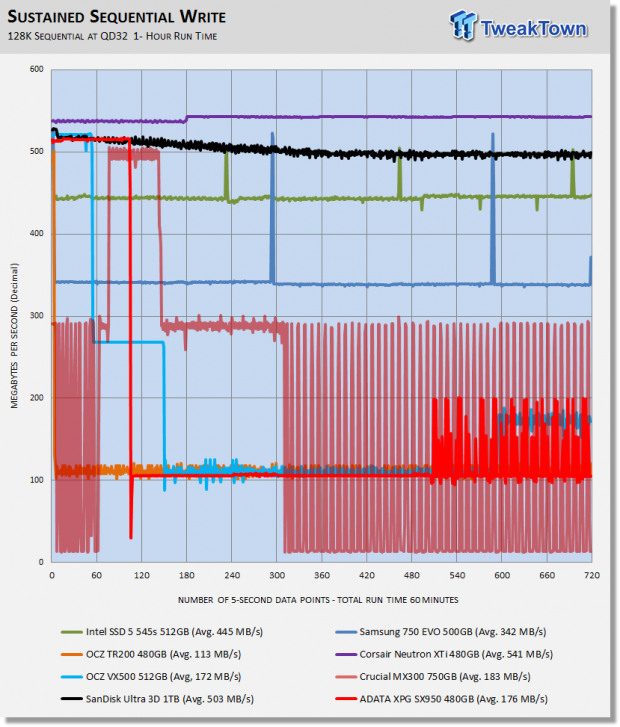
Here we can see the unmasked sequential write performance of the SX950, and it doesn't look very good. We suspect that the SX950 doesn't utilize direct-to-die write technology, and it is continuously filling and flushing the SLC cache, causing erratic and unexpectedly low sustained sequential write performance. However, we will take this result with a grain of salt, because the SX950 did exceptionally well with our transfer testing.
Maxed-Out Performance (MOP)
This testing is just to see what the drive is capable of in an FOB (Fresh Out of Box) state under optimal conditions. We are utilizing empty volumes of Windows 10 and Windows Server 2008 R2 64-bit for this testing.
Windows 10 MOP
ADATA XPG SX950 480GB SATA III SSD
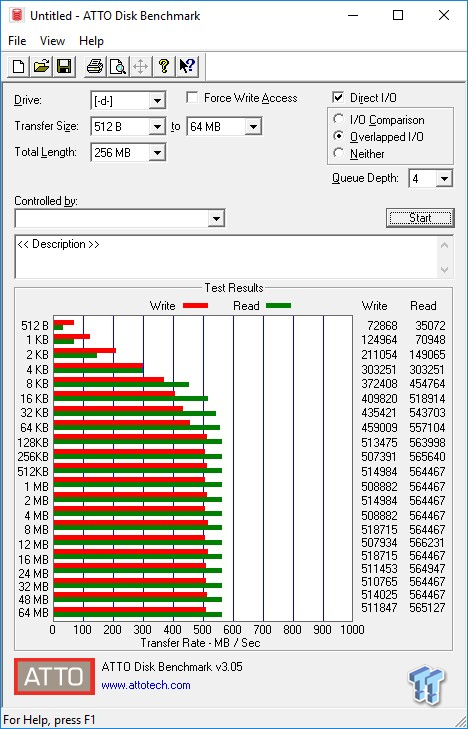
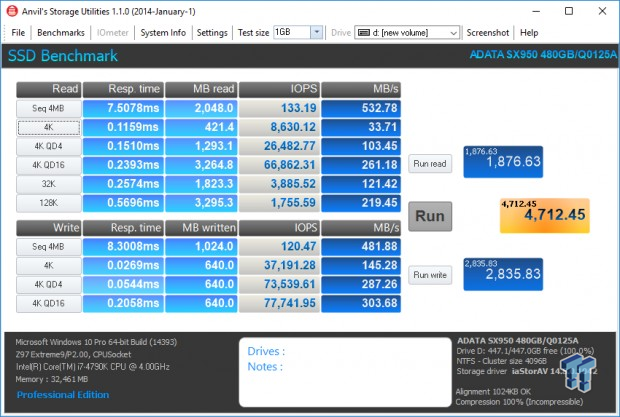
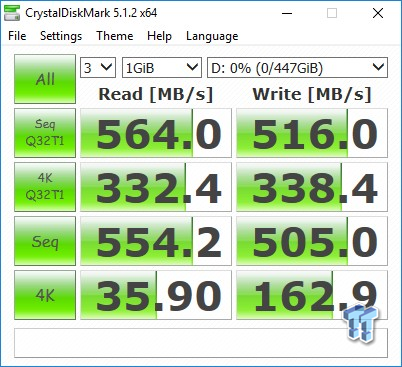
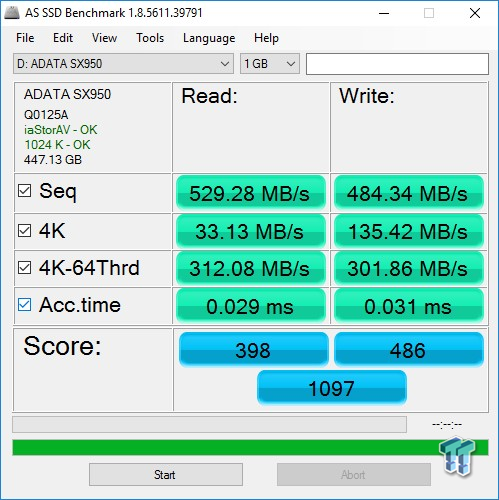
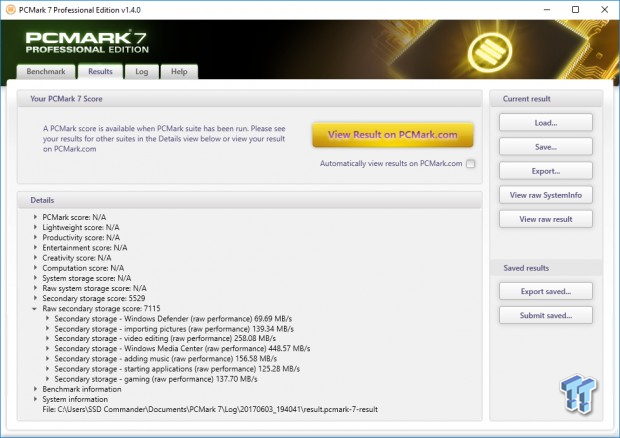
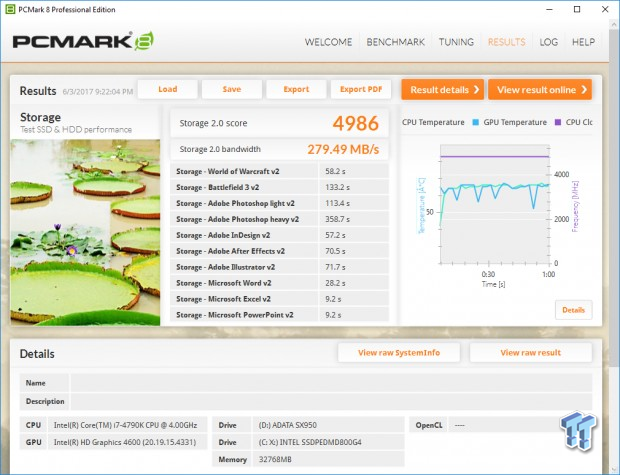
Windows Server 2008 R2 MOP
ADATA XPG SX950 480GB SATA III SSD
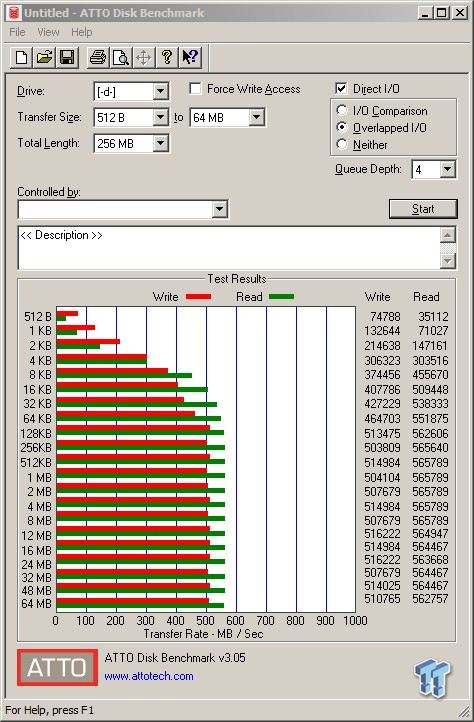

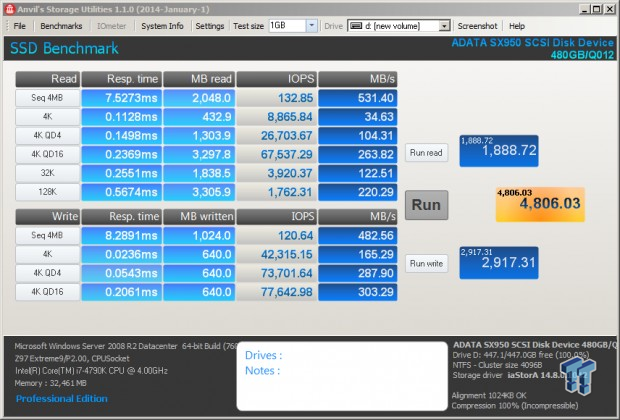
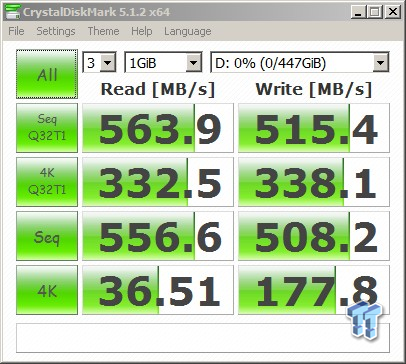
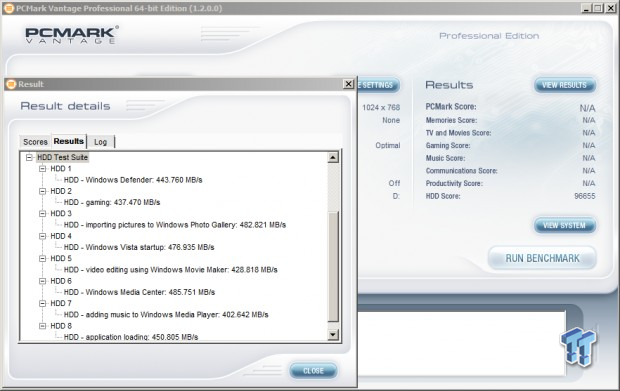
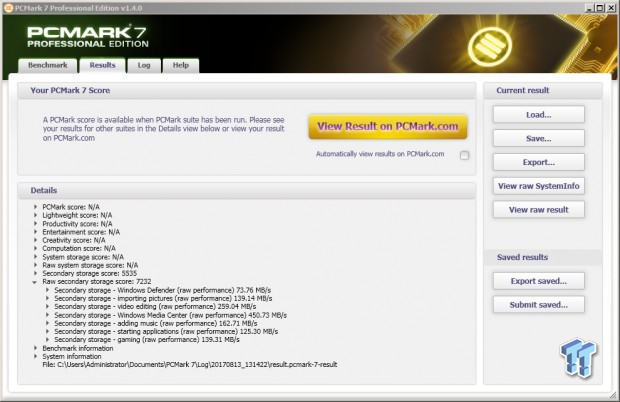
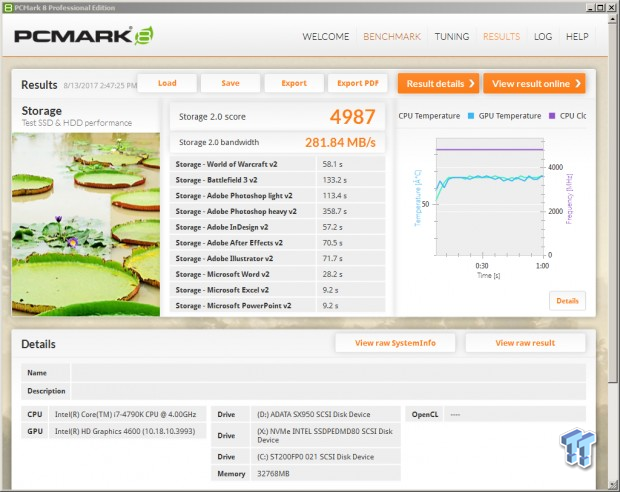
Final Thoughts

The ADATA XPG SX950 480GB SATA III SSD was built with the idea of utilizing the best available components. Like we stated at the beginning of the review, the XPG SX950 is a premium class SSD that will appeal to those that want exceptional moderate and heavy workload performance with massive amounts of endurance. We find the XPG SX950 does indeed deliver those premium qualities.
In terms of synthetic performance, the XPG SX950 doesn't light up our charts. In fact, as far as synthetic performance is concerned, the XPG SX950 only delivers average performance. As we saw, the SX950 often delivered synthetic numbers that were lower than many of the lesser SSDs in our test pool. However, we consider synthetic performance to be far less important than moderate workload performance.
We firmly believe that any SSD that we consider a Tier-1 SSD must deliver outstanding real-world performance. Of all the tests we run, we believe that PCMark 8 and SYSmark most accurately represent real-world performance. Of those two tests, we feel that SYSmark holds the greater importance because it consists of actual applications running on the system disk. There is no way to optimize firmware for SYSMark. The results are as real as it gets, and this is where we find the XPG SX950 delivering the goods in a big way. The SX950 gave us a higher overall SYSmark rating than three of our current favorite SSDs. In fact, the SX950 gave us our highest SYSmark rating of any SATA SSD we've tested to date.
User Experience: In the end, it all comes down to user experience. The ADATA SX950 delivers a Tier-1 SSD experience that rivals that of any SATA SSD we've ever used. It is very responsive, boots super-fast and handles multi-tasking without skipping a beat. We came away impressed with the ADATA XPG SX950 SATA III SSD which is why it is TweakTown recommended.
Pros:
- Application Performance
- MLC Flash
- Endurance
Cons:
- Synthetic Performance

